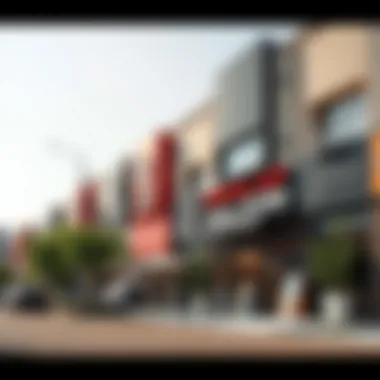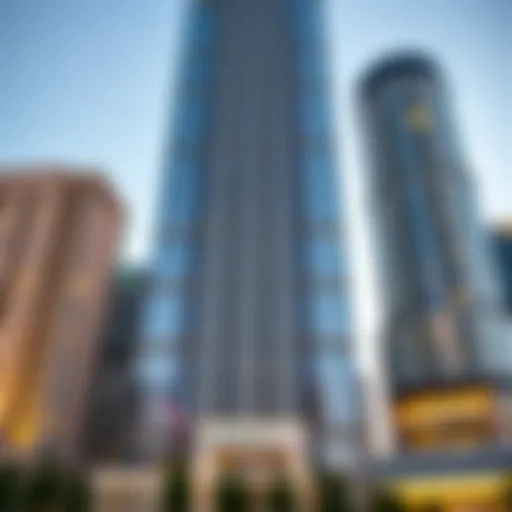Affordable Living in Dubai: Budget-Friendly Areas


Intro
Dubai, often perceived as a city of luxury and opulence, hides an intriguing aspect that many overlook: its affordable residential areas. While sparkling skyscrapers and lavish shopping malls draw attention, a treasure trove of budget-friendly neighborhoods exists, waiting to be discovered by savvy renters, homebuyers, and investors. This article aims to shine a light on these undiscovered gems, providing valuable insights, characteristics, and amenities that make these districts appealing.
The real estate market in Dubai can be quite dynamic; prices can fluctuate based on numerous factors such as demand, location, and broader economic conditions. However, even amidst such volatility, affordability persists in certain neighborhoods. As we explore these areas, we will delve into how they stand out amidst Dubai's ever-evolving landscape, ensuring potential residents can make informed choices.
Given the current economic climate, understanding the characteristics of affordable living in a city like Dubai becomes vital for those looking to strike a balance between cost and quality of life. This guide aims to dissect various neighborhoods, focusing not only on price tags but also on the lifestyle, transport links, and community amenities available in these areas.
By the end of this article, readers will be equipped with a holistic understanding of the factors contributing to affordability in Dubai's real estate market. Whether you're a renter, a potential homebuyer, or an investor, the insights provided here will assist in navigating the vibrant but often complex tapestry of Dubai's residential landscape.
Prelims to Affordable Living in Dubai
Dubai stands as a beacon of luxury and opulence, but beneath its gloss and glamour lies a diverse tapestry of residential options that cater to various budgets. As more people globally seek a foothold in this thriving emirate, the conversation surrounding affordable living has gained momentum. Understanding affordable living in Dubai isn’t just about finding a roof over one’s head; it encompasses the broader implications of lifestyle quality, economic factors, and the growth potential in less commercialized neighborhoods.
Affordability in Dubai is a multi-faceted topic. On one hand, expats and individuals from various walks of life are eager to tap into the city's flourishing job market. On the other, the stark contrast between high-end and budget-friendly housing can be daunting. For investors or homebuyers, navigating this landscape requires not just a keen sense of market trends but also an understanding of their own needs and aspirations. Factors like proximity to key amenities, safety, and community cohesion often hold just as much weight as price.
Choosing affordable neighborhoods allows newcomers to settle down without breaking the bank. There are numerous benefits associated with this choice. Take, for instance, the increased accessibility to education and healthcare facilities, which can significantly enhance the quality of life. Additionally, affordable areas often have hidden gems that reveal the city’s culture, from local markets to parks that promote community engagement.
It's essential to weigh certain considerations while exploring affordable living in Dubai. The fluctuating nature of the real estate market can impact prices significantly, influenced by various components like supply and demand, government regulations, and even economic shifts. Understanding these dynamics empowers potential residents, investors, and renters to make informed decisions.
"Navigating through the maze of Dubai's real estate can feel like searching for a needle in a haystack, but finding an affordable gem is possible with the right insights."
In the following sections, we will examine the core factors affecting residential affordability, foray into key residential areas renowned for their budget-friendly appeal, and explore the ever-evolving dynamics that shape the landscape of affordable living in this remarkable city.
Understanding Dubai's Real Estate Market
Dubai’s real estate market represents a unique confluence of cultural influences, economic indicators, and ever-evolving trends. This layer of complexity shapes how affordable living can be navigated in the city, making it crucial for potential residents, investors and even realtors to have a firm grasp of the landscape.
Understanding the real estate market in Dubai goes beyond just knowing what properties cost. It dives into why prices fluctuate, what local and international factors come into play, and where the best opportunities lie for budget-conscious buyers and renters. Keeping an eye on specific elements like market demands, availability of housing, and economic stability can reveal insights that might not be immediately evident through surface-level observation.
Furthermore, the implications of the real estate market stretch into various facets of life in Dubai, such as community development, infrastructure improvements, and overall living experience. As such, it is essential for anyone looking to settle down in this vibrant city to comprehend the intricate web of connections within the market.
The Impact of Economic Factors
In any city, understanding the real estate market is intricately tied to economic factors. Dubai's economy is a melting pot that significantly impacts both property values and rental affordability. Elements like oil prices, trade dynamics, and tourism trends have far-reaching implications. When oil prices soar, the economy often rebounds, leading to increased demand for both residential and commercial properties. Conversely, economic downturns can lead to decreased demand, pushing prices down and creating a more favorable environment for prospective buyers.
Additionally, government policies play a key role. For instance, initiatives aimed at attracting foreign investment can stimulate construction and boost housing prices. Likewise, any shakeup in regulations—such as visa policies or tax changes—can either enhance or restrict the flow of new residents into the city, thereby affecting housing demand.
The cyclical nature of economic growth and price modulation has a tangible effect on the options available for affordable living in Dubai.
Trends in Housing Prices
Trends shape residential spaces in Dubai, revealing patterns that can help renters and buyers make informed choices. Notably, prices aren't static; they fluctuate depending on various external and internal factors. Over the past few years, areas initially branded as "up-and-coming" have seen significant increases in value as amenities develop and infrastructure progresses.
For potential residents, it's crucial to highlight key trends:
- Price Diversification: Different neighborhoods experience price movements based on their unique attributes—some might be increasing in popularity due to nearby developments while others could be stagnating or even decreasing due to oversupply.
- Market Segmentation: The luxury segment often garners higher prices, pulling maturity into more affordable sectors. Regions like Dubai Investments Park or International City garner attention due to lower price points, making them attractive for budget-conscious individuals.
- Cyclical Patterns: Reviewing historical data can assist in flagging these cycles, helping investors time their purchases strategically.
Keeping an eye on these trends allows potential residents not only to find properties within their budget but also to identify opportunities for investment, fostering financial security in a locale known for its volatile property market.
Defining Cheap versus Affordable
Understanding the distinctions between cheap and affordable is crucial when discussing living conditions in Dubai. These terms often get tossed around interchangeably, which can lead to misunderstandings about what one might expect when seeking residency in less expensive areas. The overarching objective here is to shed light on these concepts, aiding potential residents in navigating the housing landscape of Dubai.


Criteria for Determining Affordability
To truly grasp the concept of affordability in housing, various factors should come into play. Some of the most significant criteria include:
- Income Levels: One's income plays a pivotal role in determining what is deemed affordable. A lower-income household will view certain areas differently compared to higher earners.
- Housing Cost Ratios: Often, affordability is assessed using a percentage of income spent on housing. A common guideline is that one should not spend more than 30% of their gross income on housing costs.
- Local Amenities: The availability of nearby facilities like schools, healthcare, and retail outlets can make an area more desirable, which in turn can affect rental or purchase prices.
- Transportation Links: Accessibility to public transport and main roads can significantly influence housing decisions, impacting both the perceived and real costs of commuting.
A genuine commitment to understanding these criteria not only helps in identifying suitable living spaces but also ensures that financial resources are managed effectively, ultimately leading to more sustainable living choices.
Comparative Analysis with Other Gulf Cities
When examining affordability in Dubai, it’s insightful to compare it to neighboring Gulf cities. Affordability fluctuates considerably across regions such as Abu Dhabi, Doha, and Muscat:
- Abu Dhabi: Often seen as pricier than Dubai, yet some suburbs like Al Ain provide a more affordable alternative, focusing on family living and green spaces.
- Doha: Qatar’s capital presents a mixed bag; certain districts match Dubai's pricing, but alternatives exist outside the city center, catering to more budget-conscious families.
- Muscat: The cost of living in Oman’s capital is typically lower than that of Dubai, offering more affordable housing options, yet with varying amenities and lifestyle opportunities.
This comparative analysis serves as a reminder that affordable options exist beyond the confines of Dubai. By widening the scope, potential residents or investors can find desirable locations that suit both their budget and lifestyle needs. Understanding these local nuances can lead to better decision-making in a city's vibrant real estate market.
“Being informed about the nuances of cheap versus affordable can redefine your living experience in Dubai, helping you maintain a balance between cost and quality of life.”
Key Residential Areas for Affordable Living
Finding a home that fits within a budget while offering essential services and accessibility is a key concern for many residents in Dubai. Understanding the specific neighborhoods that provide affordable living options is essential not just for potential renters, but also for investors looking for outlets that promise value over time. In this context, examining the key residential areas where affordability intersects with livability reveals exciting opportunities that many often overlook.
Dubai Investments Park
Community Overview
Dubai Investments Park operates under the mantra of being both affordable and conveniently located within the emirate. This community is also known for its designated zones catering to residential, commercial, and industrial needs. It is very popular among families and working professionals who want a balanced lifestyle—where home, work, and leisure are all in one area. The unique feature here is the presence of integrated facilities, providing a crucial edge for potential tenants or buyers. Affordability here is not just about low rents; it’s also about the overall community atmosphere that keeps families returning for more.
Amenities and Accessibility
In terms of amenities and accessibility, Dubai Investments Park doesn't shy away. This community prides itself on close proximity to major transport hubs and features a myriad of shopping options. Major roads such as Sheikh Zayed Road connect residents quickly to the heart of the city. The unique integration of amenities, like schools and healthcare facilities, makes it a thoughtfully constructed space, ideal for those looking for a low-stress lifestyle. Potential downsides could include the time taken to travel during peak hours, as heavy traffic can be a real hurdle.
Market Rates Comparisons
When it comes to market rates, Dubai Investments Park stands out as competitive. Renting an apartment here is often less compared to other popular areas without compromising on quality. Comparisons show that for a similar space in other neighborhoods like Dubai Marina or Downtown, one could expect to pay significantly more. However, one should be cautious as the slower appreciation in property values might not attract every investor’s attention in this area. Still, for families seeking long-term residence, the balanced cost might be worth it.
International City
Diverse Housing Options
International City is often thought of as a melting pot, offering diverse housing options that cater to a very broad demographic. The layout encourages a mix of cultures by incorporating different architectural styles representative of various nations. This characteristic alone enhances the community's charm and is particularly appealing to expatriates. The affordability factor here is significant since units may range from economical studios to larger multi-bedroom apartments, accommodating various income levels. However, buyers should consider how cultural differences in communal living might play a role in their experience.
Community Features
The community features in International City also bolster its appeal. Parks, communal areas, and dining options abound, providing residents with leisure activities close to home. Unique aspects like themed zones add to the allure, making it perfect for families and young professionals alike. However, it’s worth noting that occasional noise from nearby commerce can detract from the tranquil atmosphere some expect in a residential area.
Investment Outlook
When you look at the investment outlook for International City, the opportunities seem promising. As the area is continually seeing an influx of residents, the demand stays steady, which usually translates to improving property values. However, one has to weigh these prospects against the regional economic shifts that can impact growth. Many investors see potential here, particularly for those willing to hold onto properties for extended periods, seeking gradual appreciation.
Al Quoz
Industrial Roots
Al Quoz’s history as an industrial hub presents a unique perspective for potential homebuyers. The transition from factory spaces to residential developments showcases the area's adaptability and appeal. Homes here boast a unique charm—often featuring larger spaces and earning reputations for trendy loft-style apartments. This core characteristic not only adds character but also draws in professionals who want a different living experience. Nevertheless, it’s essential to keep in mind that this industrial legacy may bring about some challenges, such as noise from ambient activities.


Conversion to Residential
The conversion of Al Quoz from industrial to residential spaces has garnered significant attention. Developers saw potential where others saw industrial zones, leading to innovative living solutions that blend creativity with functionality. The unique selling point lies in the availability of creative lofts and artistic communal spaces that resonate with free spirits and the artsy crowd. Still, buyers should consider the ongoing developments, which may enhance property values but could also cause temporary disturbances due to construction.
Value Proposition
When examining the value proposition of living in Al Quoz, one must take multiple angles into account. The cost of living here is still relatively affordable, especially compared to areas like Downtown Dubai. This affordability is coupled with a growing community of influencers and artists who continue to shape the lifestyle in the area. However, potential downsides include limited access to certain amenities commonly found in residential neighborhoods and the ongoing push for residential development that could disrupt existing dynamics.
Jumeirah Village Circle
Modern Developments
Jumeirah Village Circle is acclaimed for modern developments that focus on family living without breaking the bank. The planned nature of the neighborhood ensures a cohesive community that stands out for its focus on modern architecture. This factor alone attracts many expats and locals alike. The major downside is that emerging areas often take some time to develop fully, and those seeking a ready-made community might find this a detraction.
Family-Friendly Environment
This area's family-friendly environment is another compelling reason for its appeal. Parks and play spaces exist alongside residential units, creating an ideal setting for growing families. Not to mention the highly regarded schools nearby that add an extra layer of desirability. Nevertheless, some families note that the limited number of retail outlets can be a drawback, as relying on nearby areas for shopping needs may be inconvenient.
Rental Market Insights
Inspecting the rental market in Jumeirah Village Circle reveals that prices can be achieved below market averages for expatriates looking for value. The unique aspect here is the rising demand due to families moving in, which could eventually hike prices in future years. For investors, the current rental yield is attractive, yet one must stay vigilant regarding the local regulations changing as the area rapidly develops.
Dubailand
Future Developments
Dubailand is showcased as a promising area with future developments drawing significant interest. Designed to be a vibrant lifestyle destination, the upcoming projects are likely to enhance the area’s appeal even more. Those considering investment should keep an eye on how these developments mature, as they often shape community profiles substantially. However, unchecked progress could lead to unforeseen challenges, such as increased congestion or changing neighborhood dynamics down the line.
Amenities for Residents
With various amenities earmarked for future developments, Dubailand aims to cater to a diverse audience. Future shopping centers, parks, and community facilities are in the pipeline. This feature enhances the living experience tremendously and provides plenty of conveniences for families and professionals alike. Some critics may argue that until these features are fully developed, living in the area might feel somewhat incomplete.
Long-Term Viability
Looking at Dubailand's long-term viability as an affordable housing area presents interesting arguments. The government’s backing and investment seen in current projects point toward a stable future. Investors could benefit significantly from early investment now, although individuals need to weigh the risks involved, such as fluctuations in market conditions that could impact property values temporarily.
Factors Affecting Residential Affordability in Dubai
Understanding the dynamics that drive residential affordability in Dubai is crucial for anyone considering moving to or investing in this vibrant city. The interplay between market forces, government policies, and social trends defines what it means to find affordable housing. Affordable doesn’t just mean cheaper; it can also signify value, access, and opportunities for vibrant community living. We’ll delve into two significant aspects here: the economic factors influencing the market and how current government initiatives are shaping the landscape of affordable housing.
Economic Growth and Its Implications
Dubai's economic growth is the lifeblood of its real estate sector. With its status as a global business hub, the city continues to attract expatriates and investors alike. The implications of this growth are multifaceted. On one side, an expanding economy fosters job creation, leading to rising demand for housing. More people flocking to the Emirate drive up property prices. However, the silver lining is that economic growth can also lead to increased investment in affordable housing projects. Developers start seeing the need to balance luxury developments with cost-effective options, recognizing the market segment that seeks value.
As the economy strengthens, the potential for new infrastructure projects emerges. Enhanced transport links and public facilities can make previously neglected areas appealing to families and young professionals looking for reasonably priced accommodations.
Key Considerations:
- Increased job opportunities can stimulate housing demand.
- Infrastructure development can enhance the appeal of less expensive areas.
- Economic growth presents both challenge and opportunity for budget-conscious residents.
Government Initiatives Promoting Affordable Housing
Recognizing the urgent need for affordable housing, the Dubai government has embarked on a variety of initiatives aimed at making quality residential options available to a broader demographic. One noteworthy initiative includes the introduction of various housing schemes intended to ease investors and buyers into the market. For instance, with the Mohammed Bin Rashid Housing Establishment interventions, many middle-income families can secure homes without stretching their budgets too thin.
Additionally, policies aimed at increasing the supply of affordable properties directly influence market prices. By encouraging developers to prioritize these projects through incentives, the government contributes to combating inflation in housing costs.


Factors to Note:
- Housing schemes with financial support make home buying accessible.
- Regulatory incentives help guide developers toward affordable housing projects.
- Balanced supply can stabilize or even reduce property prices in over-saturated markets.
"The government’s role in shaping the affordable housing landscape is not just an economic necessity but also a social responsibility."
These factors combined create a landscape where affordability is no longer a distant dream but an attainable reality for many aspiring to call Dubai home. Understanding these dynamics arms potential residents and investors with the knowledge they need to navigate the city's real estate market confidently.
Evaluating Neighborhood Amenities
When considering the cheapest residential areas in Dubai, the evaluation of neighborhood amenities plays a pivotal role. It's not just about a wallet-friendly rent; the quality of life offered by a neighborhood can greatly impact decisions made by potential residents, investors, or renters. Individuals are usually looking for places that provide convenience, comfort, and community spirit—elements that can make or break their living experience.
Benefits of understanding neighborhood amenities include:
- Enhanced Quality of Life: Access to parks, schools, and healthcare can uplift daily living.
- Investment Value: Areas with solid amenities often see a rise in property value, which can be crucial for investors.
- Social Connectivity: A well-equipped neighborhood fosters connections among residents, enhancing community bonding.
Transport and Accessibility
Public Transport Options
Public transport options in Dubai are quite extensive, catering to a diverse populace. Having access to metro lines, trams, and buses can be a boon, especially for those who prefer not to own a car. The Dubai Metro, in particular, is known for its efficiency and coverage across key neighborhoods, making it a valuable choice for residents seeking ease of travel.
One unique feature of public transport in Dubai is the Nol Card, which enables seamless transfers across various modes of transport. This system reduces stress and allows for easy budgeting of travel expenses. However, while public transport is highly regarded, it's essential to note that certain neighborhoods might have limited access to metro stations, potentially making daily commutes a hassle for some residents.
Proximity to Major Roads
Living near major roads can significantly ease commuting woes. Areas located close to main thoroughfares, like Sheikh Zayed Road, offer residents quick access to business hubs and attractions across Dubai. This proximity is beneficial for those who work or regularly travel to the city's commercial centers, making it popular among professionals.
A unique characteristic of these major routes is their connectivity—one can easily navigate to various parts of the city without the convoluted local traffic. However, the downside could be increased noise levels and pollution, which may deter some potential renters or buyers.
Community Facilities
Parks and Recreation Areas
Parks and recreation areas are often seen as communal living rooms. They serve as spaces for social interaction, exercise, and leisure. Many of Dubai's affordable neighborhoods boast green spaces and parks, which hold significance for families looking for recreational options. Access to parks not just enhances the lifestyle of residents but can also provide a space for community events and activities.
A striking feature of parks in Dubai is their design—many are equipped with jogging trails, playgrounds, and fitness areas. However, the downside can be that as these areas attract more residents, they may get crowded, changing the vibe of what was once a peaceful green space.
Shopping and Dining Options
Having nearby shopping and dining options adds another layer of allure to affordable neighborhoods. Access to grocery stores, markets, cafes, and restaurants makes day-to-day living more convenient. Dubai's vibrant dining scene often seeps into even the less expensive neighborhoods, providing residents with diverse cuisines without needing to travel far.
One major benefit is the potential for fostering local businesses, enhancing community engagement. However, it’s important to be mindful that the growth of commercial avenues can lead to increased traffic and noise, which might not sit well with some residents looking for tranquility.
Culmination: Finding Value in Affordable Areas of Dubai
The significance of identifying value in the cheaper residential zones of Dubai cannot be overstated, particularly for individuals contemplating relocation or investment. This exploration reveals an important dynamic in the fast-paced and often daunting real estate market of Dubai.
Dubai is more than just its glitzy skyline and luxury malls; it hosts a plethora of neighborhoods where affordability meets convenience. These areas embody the potential to offer a comfortable, sustainable lifestyle without breaking the bank. Understanding the nuances of affordable living means one can spot opportunities that can lead to both financial stability and enhanced quality of life.
Many potential residents, whether they're young professionals or families, find themselves caught in a dilemma between price and lifestyle. It’s not simply about finding the lowest rent; it is about discovering locations that provide essential amenities, community spirit, and accessibility.
To summarize, when searching for affordability:
- Research local amenities: Access to schools, hospitals, and recreational spaces can greatly enhance living quality.
- Consider transport links: Areas with good public transport options often save time and reduce commuting costs.
- Evaluate future growth: Some neighborhoods may seem inexpensive now but have potential for appreciation, making them wise investments.
Investors, analysts, and homebuyers should closely monitor these factors to make informed decisions that align with their financial goals and lifestyle preferences. Here’s a quick glance at what to keep in mind:
- Affordability shouldn't compromise quality: Ensure the area provides essential services and community support.
- Stay updated on market trends: Knowledge of potential developments in the area can provide insights into future property value increases.
- Engage with the community: Understanding the community vibe can signal a supportive and friendly environment, which is often overlooked.
"Affordable living in Dubai is not just a pipe dream; it’s a reality waiting for the right seekers to discover."











